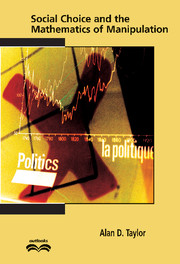9 - Other Election-Theoretic Contexts
Published online by Cambridge University Press: 07 December 2009
Summary
Introduction
Throughout the book, we have uniformly imposed certain restrictions on the election-theoretic contexts that we considered. In particular, we assumed the following:
Ballots are lists (with or without ties) of the set A of alternatives.
An election outcome is either an alternative, a set of alternatives, a list, or a choice function.
In this concluding chapter, we briefly consider a few results that apply to situations that go beyond these assumptions.
In Sections 9.2 and 9.3, we consider two natural contexts in which a ballot is a set of alternatives. Here, we discuss an important voting system known as approval voting, and we present a very pretty result due to Barber, Sonnenschein, and Zhou.
Finally, in Section 9.4, we present an elegant theorem of Allan Gibbard that takes place in the context wherein the outcome of an election is a “probability vector” that, in a very rough sense, gives the probability that each alternative will eventually emerge as the unique winner. Gibbard's theorem completely characterizes systems of this type that are non-manipulable.
Ballots That Are Sets: Approval Voting and Quota Systems
A natural election-theoretic context is the one in which a ballot is a set of alternatives, and the outcome of an election is also a set of alternatives. For the sake of mathematical naturality, we allow ballots and outcomes to be the empty set.
- Type
- Chapter
- Information
- Social Choice and the Mathematics of Manipulation , pp. 160 - 166Publisher: Cambridge University PressPrint publication year: 2005

